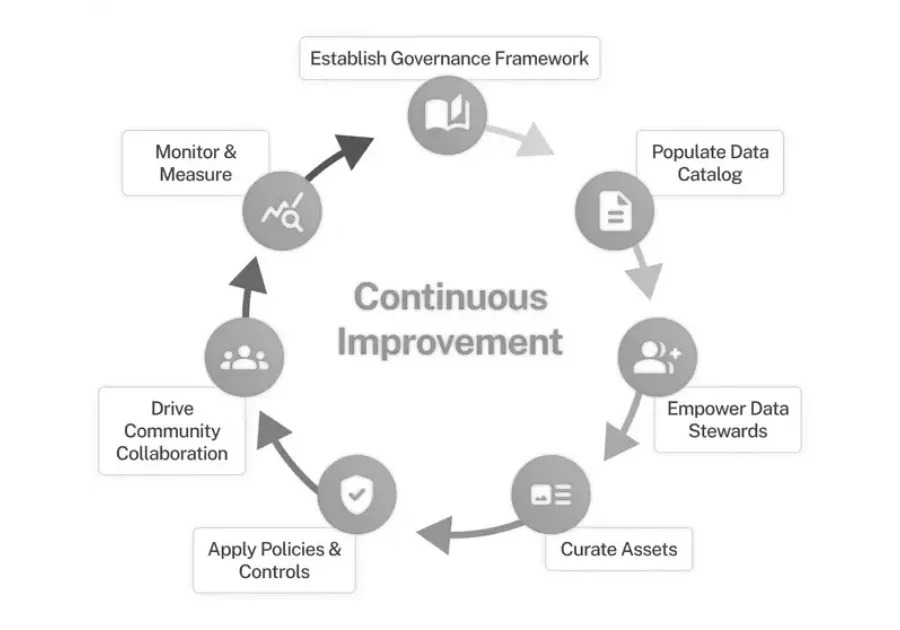Our commitment treating organizational data as a corporate asset and intellectual property is commendable. By implementing a Data Governance approach that spans all internal and external IT systems, we're ensuring comprehensive data protection and quality. The decision-making mechanisms we establish, which transcend organizational silos, foster both accountability and collaboration at the enterprise level.
Interested in learning more about our IT services? Contact us today to schedule a consultation with one of our experts.
What are the costs of poor data governance, including missed opportunities, time wasted on manual data cleaning, and incorrect business decisions?
Who currently oversees governance efforts, and how can we elevate this discussion to the executive level? Which stakeholders should be included?
In which areas is governance most critical? Which specific domains or parts of the organization require the most attention at this time?
Which governance model is most suitable for the organization, and do current initiatives meet that level of requirement?
How can we speed up governance by refining its focus and incorporating iterative working methods?.
Do you have the in-house expertise and resources to successfully manage this transition?

Goals: It describe why we govern data. Without goals, governance lacks the focus needed to deliver value and align with business objectives.
Methods: It describe how we govern data by establishing policies and using guides, guardrails, and gates. These methods are key to preventing problems, intervening when needed, and enforcing rules.
Human Element in Data Governance: At the core of data governance are people. We don't govern the data directly; we govern how people interact with it. This includes a wide range of individuals such as sponsors, owners, stewards, curators, coaches, consumers, and other stakeholders.
Purpose of Processes: Processes involve a sequence of actions designed to achieve specific results, such as addressing issues, managing changes, maintaining data quality, organizing datasets, and evaluating the impact of data governance.
Technology's Role in Managing Data: Technology is integral to data management, handling tasks like data ingestion, cataloging, preparation, analysis, and pipeline management. Each technology offers specific features and functions that contribute to data governance.
Cultural Norms for Integration: The establishment of cultural norms helps create an environment where data governance, agile projects, and self-service data analysis and reporting can work in unison without any conflicts.
We begin with filling the data catalog with business-critical information , grasp the key goals of the organization and foster a collaborative relationship. This approach ensures the vision effectively and securely harnesses the power of your organization's data for all stakeholders..
Identify and empower individuals who can provide insights about your data. Eliminate repetitive manual tasks by automating processes like data classification and policy assignment. This allows data stewards to concentrate on their most impactful work..
We Start by adding detailed descriptions to your data assets, create glossaries to define key terms and metrics clearly. Establish data governance policies to ensure proper data usage. Each of these steps forms a solid foundation, helping others understand and use the data correctly
Implementing data governance policies alongside your data is crucial for maximizing its potential. Making these policies visible before data use ensures everyone knows how to handle the data properly.
Promote trusted data use by highlighting the benefits of accessible, understandable, and reliable data. Encourage open discussions about data and policies to build confidence in data usage.
Demonstrate to key stakeholders how our actions enhance policy compliance and ease audit concerns. Celebrate successes and reflect on areas for improvement.


Removes barriers to data retrieval, ensuring that data can be found and used efficiently, and implementing systems and policies that facilitate seamless access to data resources.

Ensure that data remains accurate, consistent, and reliable throughout its lifecycle. This involves protecting data from unauthorized alterations, ensuring that it is correctly and consistently recorded, and preserving its accuracy during storage, retrieval, and processing.

This involves implementing processes and checks to verify that data is entered, stored, and maintained without errors. It also includes regular audits and validations to detect and correct any inaccuracies, ensuring that the data can be trusted for decision-making and analysis.

It involves implementing robust security protocols and practices to ensure data remains safe and secure.
Please reach us at edgequadllc@gmail.com if you cannot find an answer to your question.